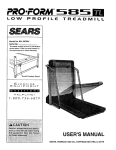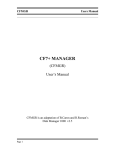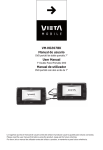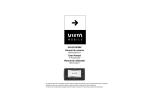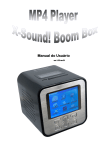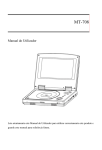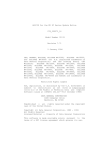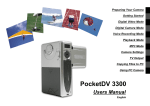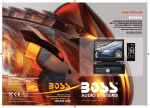Download ESI K.ON User`s guide
Transcript
Expandable Controller Keyboard User’s Guide ESI - Copyright © 2007 Revision 1, November 2007 www.esi-audio.com K.ON ESI INDEX 1. Introduction.................................................................................................................................. 4 1.1 Main Features....................................................................................................................................................... 4 2. Hardware Installation ................................................................................................................. 5 3. Software Installation.................................................................................................................... 5 4. Features & Functions................................................................................................................... 6 4.1 Function Buttons.................................................................................................................................................. 6 4.2 Additional Functions............................................................................................................................................ 9 4.3 Pitch and Modulation Wheels ............................................................................................................................ 10 4.4 Pedal Connectors ............................................................................................................................................... 11 4.5 Controller Knobs & Faders ................................................................................................................................ 11 4.6 Transport Controls ............................................................................................................................................. 12 4.7 Controller Assignment ....................................................................................................................................... 12 4.8 Save & Load Functions...................................................................................................................................... 13 5. Tables with Default Values ....................................................................................................... 15 5.1 Controller Knob Defaults (KNx - FUNC_A)..................................................................................................... 15 5.2 Faders Default (CSx - FUNC_B)....................................................................................................................... 15 5.3 Transport Controls MIDI Parameter .................................................................................................................. 15 5.4 MIDI Controller List.......................................................................................................................................... 15 6. General Information .................................................................................................................. 17 3 K.ON ESI 1. Introduction Thank you for purchasing K.ON. K.ON is an expandable USB controller keyboard. Equipped with a stable aluminium cabinet, K.ON is not only stylish, but perfectly optimized for professional usage live on stage or in any studio environment. Various faders and dials as controllers are provided, allowing remote control of software and hardware synthesizers. K.ON has a total of 4 expansion slots, compatible with existing synthesizer modules from other vendors. Please note that this document covers the basics of the K.ON installation as well as the usage of the various built-in functions. However, this manual is not intended to explain the basics about MIDI, MIDI controller messages, MIDI programs, MIDI channels or anything about typical audio-/MIDI sequencing software. If you need to get more information about MIDI (i.e. you don’t know what a MIDI controller actually is for example), a good start is usually the manual of your notation or sequencing software (i.e. the included Cubase LE 4.0). In addition there are a lot of details about MIDI on the Internet. A good technical resource and great starting point is www.midi.org, some details are typically also provided in various forums about audio / MIDI and home recording. 1.1 Main Features · · · · · · · · · · · · · 4 88 keys professional hammer action keyboard, with channel after touch function 8 assignable controller knobs, with presets for Cutoff, Resonance, Attack, Release, Pan, Reverb, Chorus, and Tempo 9 assignable controller faders, with presets including control of volume of channel 1-16 and the master volume 6 remote control buttons for audio and sequencer software, providing real-time remote control of Record, Play, Stop, Fast Forward, Skip Backward and Return Pitch and Modulation wheels possibility to able to save/load 10 user parameter groups various function buttons LED data display, displaying the current state one MIDI output USB port, support USB 1.1, directly powered via USB bus 3 available expansion slots bundled with Cubase LE 4.0 DVD-ROM compatible with various Windows versions and Mac OS X K.ON ESI 2. Hardware Installation Before driver installation, please locate your original Windows CD (if you are using Windows), as you may need it during installation. Please also make sure to install the chipset drivers for your motherboard if you have not done so already. Find the USB port on your computer. A sample USB port is pictured below. It is typically located next to the PS/2 or serial ports on the back of your computer. Plug the K.ON USB cable (Series A plug type) into the USB port of your computer. The other end of the cable will be connected with K.ON. K.ON gets the power from the computer via USB cable by default when connected to a computer and after you have switched it on. The LEDs of K.ON will be turned on once the unit is powered and connected to your PC. MIDI connection If you are not using the USB connection to your computer, you can also use the MIDI out port with a standard MIDI cable. This will be connected to the MIDI input of your MIDI interface or soundcard for example. 3. Software Installation After K.ON has been connected to your computer, you can immediately start using it. Under Windows, a new MIDI input device called USB Audio Device will be available in all your MIDI compatible applications. Under Mac OS X, a new device called K.ON will be available. This device can be selected as MIDI input source in all MIDI compatible applications. How this is done, varies from application to application, so please consult the manual for your audio/MIDI or notation software for more details. 5 K.ON ESI 4. Features & Functions 4.1 Function Buttons K.ON has various function buttons on the control surface. This section explains each of them. PROGRAM You can change the MIDI program (instrument) with the PROGRAM button. After pressing it, the LED above the button is on and the numeric display shows the currently selected program. You can change it with the selection master knob under the numeric display, by entering numbers via the numeric keypad or with the + / - buttons. All 128 standard MIDI voices are available in the range from 0 ~ 127. CHANNEL Via the CHANNEL button the MIDI channel (1 ~ 16) can be selected. After pressing it, the LED above the button is on and the numeric display shows the currently selected channel. You can change it with the selection master knob under the numeric display, by entering numbers via the numeric keypad or with the +/- buttons. TRANSPOSE The TRANSPOSE button allows you to transpose the key range of K.ON in the +/- 12 semitone (+/- 1 octave) range. After pressing it, the LED above the button is on and the numeric display shows the current value. The default value is 00. You can change it with the selection master knob under the numeric display or via the +/- buttons. OCTAVE The OCTAVE adjusting button allows you to change the main octave pitch of K.ON over a range of +/-3 semitones. After pressing it, the LED above the button is on and the numeric display shows the current value. You can change it with the selection master knob under the numeric display or via the +/- buttons. CURVE The CURVE button allows you to adjust the velocity curve. K.ON provides 5 different velocity curves (0 ~ 4). After pressing it, the LED above the button is on and the numeric display shows the current value. You can change it with the selection master knob under the numeric display or via the +/- buttons. 6 K.ON ESI DUAL K.ON provides a special function to allow you to play two simultaneous instruments / MIDI programs. Before you press the DUAL button, select the first MIDI program via PROGRAM as described above. Now press DUAL and select the second voice. After pressing it, the LED above the button is on. You can change the value on the numeric display it with the selection master knob, by entering numbers via the numeric keypad or via the +/- buttons. K.ON will then transmit the MIDI information on two channels simultaneously. By default, the two voice or DUAL mode plays the second instrument on the next MIDI channel (i.e. if the current MIDI channel is 1, the second instrument will be played on channel 2). As long as DUAL mode is enabled (as indicated by the LED above the button), the CHANNEL button will change the MIDI channel for the second instrument. Please note that the DUAL mode and SPLIT mode cannot be used simultaneously. To disable DUAL mode, press the DUAL button again. The LED above the button will be off. SPLIT K.ON also provides a keyboard split function that allows you to divide K.ON into two different split zones with different MIDI instruments – the SPLIT mode. First make sure to setup all parameters for the low tone. Then press SPLIT to start the split function – the indicator LED will be turned on. Now you can start and edit the parameters for the high tone. The default split point is central C (MIDI value 3C). If you want to change the split point, you need to do this before enabling SPLIT mode (i.e. the LED above the button is off). Press and hold the SPLIT button and then touch the key you want to assign as split point. Release the SPLIT button and press it again to enable SPLIT mode (the LED will be turned on) with the new split point. If you want to modify the split point, can press SPLIT constantly, then press a key to select the split point. After that, release the SPLIT. By default, the SPLIT mode plays the second instrument on the next MIDI channel (i.e. if the current MIDI channel is 1, the higher instrument will be played on channel 2). As long as SPLIT mode is enabled (as indicated by the LED above the button), the CHANNEL button will change the MIDI channel for the higher instrument. Please note that the SPLIT mode and DUAL mode cannot be used simultaneously. TOUCH The TOUCH button allows you to turn on/ off channel after touch. CONFIGURE With the CONFIGURE button, you can assign different MIDI controller functions to the various faders & control knobs of K.ON. How this is done is explained in section 4.7. 7 K.ON ESI SELECT With the SELECT button, you can select the controller knob and fader and then control its value via the master knob under the numeric display. The usage is further explained in section 4.7. FUNC_A The FUNC_A button allows you to select between the predefined and user controlled MIDI controller values for the controller knobs. The LED next to the button shows the current selection. The top LED indicates usage of Cutoff, Resonance, Attack, Release, Pan, Reverb, Chorus and Tempo while the lower LED indicates the usage of the user defined values (KNx). Check the table in section 5.1 for more information. FUNC_B The FUNC_B button allows you to select between the predefined and user controlled MIDI controller values for the controller knobs. The LED next to the button shows the current selection. The top LED indicates usage of Volume for channel 1 ~ 8, the mid LED indicates volume for channel 9 ~ 16 and the lower LED indicates the usage of the user defined values (CSx). Check the table in section 5.2 for more information. +, - button The + and – buttons of K.ON are used to enter values by increasing or decreasing values when changing or entering them. Master Knob The master knob is positioned under the main numeric display. It is used to adjust values when changing or entering them. 8 K.ON ESI Numeric Keypad You can also enter values with the numeric keypad. To fill out empty spaces, use 0. 4.2 Additional Functions K.ON has more functions that are typically accessed by pressing two buttons at the same time. This section explains these. RESET Pressing PROGRAM and CHANNEL buttons at the same time sends out a system reset command. K.ON returns to its initial settings and sends the system reset information at the same time. The numeric display will blink to indicate the reset process. Note that the device connected must support the reset command – or it may not respond accordingly. LINK Via the link function (pressing OCTAVE and CURVE simultaneously), the MIDI I/O routing of K.ON can be changed. The modes are 0, 1 and 2. Check the following diagrams for a description of each of them: Mode 0 USB in K.ON USB out PC MIDI out In this mode, the K.ON port needs to be selected as MIDI output device in the corresponding audio sequencer software, so that the MIDI port can send out data from the computer. This allows you to use K.ON as a USB MIDI interface and you can control other devices from your computer via the MIDI output port of K.ON. Mode 1 USB in K.ON PC MIDI out In this mode, no MIDI signals can sent out from the computer via USB, however the computer is still receiving all signals from K.ON. Use this mode to control other devices that are connected to the MIDI output of K.ON directly from K.ON, independently from the computer. 9 K.ON ESI Mode 2 USB out PC MIDI out K.ON In this mode, the computer receives no signals from K.ON via USB. The signals are sent directly to the MIDI output port instead. Also signals sent by the PC are sent directly out to the MIDI output port. This allows you to use K.ON and the computer simultaneously to control an external device connected to the MIDI output port of K.ON. ALL NOTE OFF When pressing the buttons SPLIT and TOUCH simultaneously, K.ON will send out the all notes off MIDI command (controller #123). Use this function when you have problems with hanging notes on your system or sound module. Please note that not all devices support this MIDI command, so in some cases it might simply not work. GM ON Pressing CHANNEL and TRANSPOSE at the same time will send GM initialization information (MIDI values F0 7E 7F 09 01 F7). XG ON Pressing CURVE and DUAL buttons at the same time will send XG initialization information (MIDI values F0 43 10 4C 00 00 7E 00 F7) GS ON Pressing TOUCH and CONFIGURE buttons at the same time will send XG initialization information (MIDI values F0 41 10 42 12 40 00 7F 00 41 F7) Please note that the GM/GS/XG initialization functions only have an effect if the connected device supports these commands. 4.3 Pitch and Modulation Wheels Rotating the PITCH wheel during performance can change the pitch of the current performance (typically one tone above or below). However, the PITCH wheel can be reconfigured to send out another MIDI controller. Rotating the MODULATION wheel during performance typically adds a tremolo effect to the sound. The MODULATION wheel can also be reconfigured to send out another MIDI controller. This is described in section 4.7. 10 K.ON ESI 4.4 Pedal Connectors The two pedals are by default defined as sustain (PEDAL_A LED on top and SUSTAIN connector on backside) and soft / damper (PEDAL_B LED on top and DAMPER connector on the backside) pedal. They can be reconfigured for other functions however. This is described in section 4.7. Pedal Polarity K.ON can recognize / change the pedal polarity by default. If you want to send ‘Pedal On’ while stamping on the pedal and ‘Pedal Off’ while releasing the pedal, no operation needs to be done; If you want to send ‘Pedal Off’ while stamping on the pedal and ‘Pedal On’ while releasing, you need to stamp on the pedal before the keyboard is switched on, and release the pedal until you can see the keyboard is powered on and displays something on the LED display. 4.5 Controller Knobs & Faders Controller Knobs 8 controller knobs can send out MIDI controller values. The controllers are divided into 2 groups. When the first indicator LED next to the FUNC_A button is on, it means the that the first group with preset MIDI controllers will be used. When the second indicator is on, it means that the user defined KNx MIDI controllers will be sent out instead. You can switch between the two groups with the FUNC_A button. When adjusting different controller knobs, the LED displays current adjusting values, the corresponding indicator is on, also, the value can be adjusted by knobs or +, buttons. Besides, the desired controller knobs can be selected by the SELECT button, and the values can be adjusted by knobs, number buttons, or +, - buttons. Faders 11 K.ON ESI 9 faders can send out MIDI controller values. They are divided into 3 groups. When the first indicator LED next to the FUNC_B button is on, the faders are adjusting volume of channel 1 ~ 8; when the second indicator is on, they adjust volume of channel 9 ~ 16. When the third indicator is on, the user defined CSx MIDI controllers will be sent out instead. These 3 modes can be switched by FUNC_B. Like the 8 controller knobs, the faders can be used together with knobs, number buttons or +, - buttons after selecting them with the SELECT button. M.VOLUME on the lower left adjusts the main volume. 4.6 Transport Controls The transport control buttons can be used to remote control your sequencing software. Please consult the manual of your audio / MIDI sequencing or notation software on how to control the transport functions remotely via MIDI. The table in section 5.3 shows the MIDI controller values K.ON is sending out. Depending on your software, there might be a preset that matches these values or there might be a learn function that detects the signals from K.ON and allows you to assign them to functions of the software. To start playback, you push the PLAY button. The LED above the button indicates the PLAY mode. To start recording, you push the RECORD button. A red LED indicates the RECORD mode. Please note that the PLAY and RECORD buttons can only be used after pushing STOP first as PLAY and RECORD modes are exclusive, i.e. they cannot be used simultaneously. Tempo When in PLAY or RECORD mode, K.ON sends out MIDI sync clock information. The tempo can be changed with the TEMPO controller knob (make sure to select the top row of controllers via FUNC_A button first as described in section 4.5. The tempo can be changed during playback and software or devices supporting MIDI clock information will then automatically synchronize to K.ON. If the tempo value is changed when not in PLAY or RECORD mode, it will be used the next time you push PLAY or RECORD. 4.7 Controller Assignment The 8 controller knobs, 8 faders (the first, M.VOLUME, has a fixed function and cannot be reassigned), Pitch & Modulation and the 2 pedal connectors can be used to send out different MIDI controllers by reassigning different controller values to them. Typically you need to select the fader / knob, etc. for which you want to change the assignment first and then enter into the edit mode. You can select the fader / knob via the SELECT button. Assigning to Controller Knobs Select the controller you want to assign via the SELECT button by pushing it several times and browsing through the knobs. Press the CONFIGURE button and the system enters into edit mode for the selected controller. The numeric display now displays the currently assigned MIDI controller 12 K.ON ESI number. Now you can adjust the MIDI controller value by entering the desired controller number via the numeric keypad or with the + / - buttons. Assigning to Faders Select the fader you want to assign via the SELECT button by pushing it several times and browsing through the knobs. Press the CONFIGURE button and the system enters into edit mode for the selected controller. The numeric display now displays the currently assigned MIDI controller number. Now you can adjust the MIDI controller value by entering the desired controller number via the numeric keypad or with the + / - buttons. Assigning to Pedals Enter into edit mode (start via CONFIGURE) first. Then stamp on (or release) the pedal to select the pedal. The numeric display now displays the currently assigned MIDI controller number. Now you can adjust the MIDI controller value by entering the desired controller number via the numeric keypad or with the + / - buttons. Assigning to Pitch & Modulation wheels Enter into edit mode (start via CONFIGURE) first. Then turn the Pitch or Modulation wheel. The numeric display now displays the currently assigned MIDI controller number. Now you can adjust the MIDI controller value by entering the desired controller number via the numeric keypad or with the + / - buttons. Note: As Pitch is not defined to be any standard MIDI controller in the 0 ~ 127 range, K.ON defines Pitch as 128. This means that you can always enter numbers from 0 ~ 128 for the Pitch wheel where 128 means Pitch. Finishing the Reassignment When the controller reassignment is done (i.e. you have entered the number of the required MIDI controller), press any function button to confirm the configuration and exit the edit mode. Please note that the controller knob and the fader controller should be assigned with MIDI controllers with successive variation while the pedals should be assigned with MIDI controllers with on / off variation. 4.8 Save & Load Functions K.ON can store up to 10 groups with user parameters. This allows you to make different configurations and load depending on the situation. Save Press the and buttons at the same time to enter into save mode. The 10 groups of us user parameters are saved under number 0 ~ 9. The numeric display shows “S-”, the number can be selected by entering it via the numeric keypad. For instance, if you enter 0, the LEDs display “S0”. The user parameters will be saved in group 0 then. If you are not entering a number within 2 seconds, the system returns to the state prior to the saving. 13 K.ON ESI Load and at the same time to enter into load mode. The 10 groups of us user parameters can Press be loaded via their number (0 ~ 9 ). The numeric display shows “L-”, the corresponding user parameter group that is saved can be loaded by inputting number 0-9. For instance, if you enter, the LEDs display “L0”, which means that the parameters of group 0 will be loaded. If you are not entering a number within 2 seconds, the system returns to the state prior to the loading. 14 K.ON ESI 5. Tables with Default Values 5.1 Controller Knob Defaults (KNx - FUNC_A) Grp #1 Grp #2 Name Settings Controller Defaultvalue Name Setting Controller Defaultvalue CUTOFF Cutoff 74 64 KN1 RESONANCE Resonance 71 64 KN2 ATTACK Attack 73 64 KN3 RELEASE Release 72 64 KN4 PAN Pan 10 64 KN5 REVERB Reverb 91 40 KN6 CHORUS Chorus 93 0 KN7 TEMPO Tempo 14 0 15 0 16 0 17 0 18 0 19 0 20 0 21 0 KN8 5.2 Faders Default (CSx - FUNC_B) Group #1 Group #2 Group #3 Name Channel Controller Defaultvalue Name Setting Controller Defaultvalue Name Setting Controller Defaultvalue M.VOLUME ALL(1) 113 100 M.VOLUME 113 100 M.VOLUME VOL1 1 7 100 VOL9 9 7 100 CS1 VOL2 2 7 100 VOL10 10 7 100 CS2 VOL3 3 7 100 VOL11 11 7 100 CS3 VOL4 4 7 100 VOL12 12 7 100 CS4 VOL5 5 7 100 VOL13 13 7 100 CS5 VOL6 6 7 100 VOL14 14 7 100 CS6 VOL7 7 7 100 VOL15 15 7 100 CS7 VOL8 8 7 100 VOL16 16 7 100 CS8 113 100 22 0 23 0 24 0 25 0 26 0 27 0 28 0 29 0 5.3 Transport Controls MIDI Parameter Name Controller 114,118 115 116 117 118 119 Channel 1 1 1 1 1 1 Trigger 127 127 127 127 127 127 5.4 MIDI Controller List Controller 0 1 2 3 4 5 6 7 Parameter Function Bank Select MSB Modulation MSB Breath MSB Controller Foot Cntrl MSB Portam. time MSB Data Entry MSB Channel Vol. MSB Defaultvalue Range Controller 0 0 127 0 127 0 2 100 0-127 0-127 0-127 0-127 0-127 0-127 0-127 0-127 8 9 10 11 12 13 14-31 32 Parameter Function Balance MSB Controller Pan MSB Expression MSB Effect Control MSB Effect Control MSB Controller Bank Select LSB Defaultvalue Range 64 0 64 127 0 0 0 0 0-127 0-127 0-127 0-127 0-127 0-127 0-127 0-127 15 K.ON Controller 33 34 35 36 37 38 39 40 41 42 43 44-63 64 65 66 67 68 69 70 71 72 73 74 75 76 77 16 ESI Parameter Function Modulation LSB Breath LSB Controller Foot Cntrl LSB Portam. time LSB Data Entry LSB Chnnl Volume LSB Balance LSB Controller Panpot LSB Expression LSB Controller Sunstain Portamento Sostenuto Soft Pedal Legato FootSwitch Hold 2 Sound Controller Resonance Release Time Attack Time Cutoff Decay Time Vibrato Depth Vibrato Depth Defaultvalue Range Controller 0 127 0 127 0 0 127 64 0 64 127 0 0 0 0 0 0 0 64 64 64 64 64 0 64 64 0-127 0-127 0-127 0-127 0-127 0-127 0-127 0-127 0-127 0-127 0-127 0-127 0-127 0-127 0-127 0-127 0-127 0-127 0-127 0-127 0-127 0-127 0-127 0-127 0-127 0-127 78 79 80-83 84 85-90 91 92 93 94 95 96 97 98 99 100 101 102-119 120 121 122 123 124 125 126 127 Parameter Function Vibrato Depth Sound Controller Controller Portamento Control Controller` Reverb Effects Chorus Effects Effects RPN Increment RPN Decrement NRPN LSB NRPN MSB RPN LSB RPN MSB Controller All Sound Off Reset All Contrll Local Control All Notes Off OMNI Off OMNI On Mono Poly Defaultvalue Range 64 64 0 0 0 40 0 0 0 0 0 0 0 0 0 0 0 0 0 0 0 0 0 0 0 0-127 0-127 0-127 0-127 0-127 0-127 0-127 0-127 0-127 0-127 0-127 0-127 0-127 0-127 0-127 0-127 0-127 0-127 0-127 0-127 0-127 0-127 0-127 0-127 0-127 K.ON ESI 6. General Information Trademarks ESI and K.ON are trademarks of Ego Systems Inc. and ESI Audiotechnik GmbH. Windows is a trademark of Microsoft Corporation. Other product and brand names are trademarks or registered trademarks of their respective companies. The FCC and CE Regulation Warning This device complies with Part 15 of the FCC Rules. Operation is subject to the following two conditions: (1) this device may not cause harmful interference, and (2) this device must accept any interference received, including interference that may cause undesired operation. Caution : Any changes or modifications in construction of this device with are not expressly approved by the party responsible for compliance, could void the user's authority to operate equipment. Note: This equipment has been tested and found to comply with the limits for a Class A digital device, pursuant to Part 15 of the FCC Rules. These limits are designed to provide reasonable protection against harmful interference when the equipment is operated in a commercial environment. This equipment generates, uses, and can radiate radio frequency energy and, if not installed and used in accordance with the instruction manual, may cause harmful interference to radio communications. Operation of this equipment in a residential area is likely to cause harmful interference in which case the user will be required to correct the interference at his own expense. If necessary, consult an experienced radio/television technician for additional suggestions. Correspondence For technical support inquiries, contact ESI support online at www.esi-audio.com. Disclaimer All features and specifications subject to change without notice. Parts of this manual are continually being updated. Please check our web site www.esi-audio.com occasionally for the most recent update information. 17

















